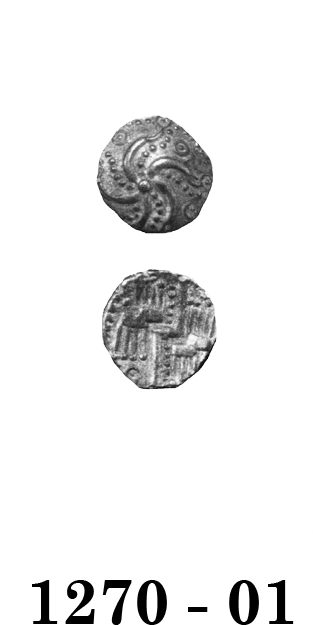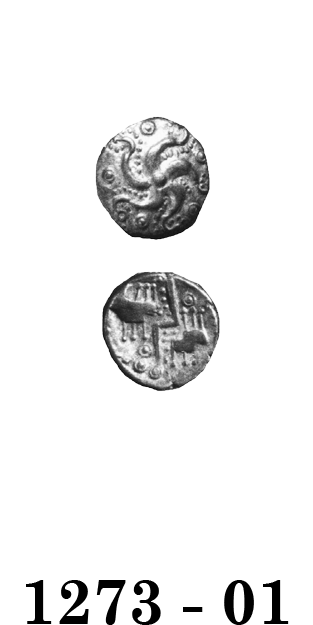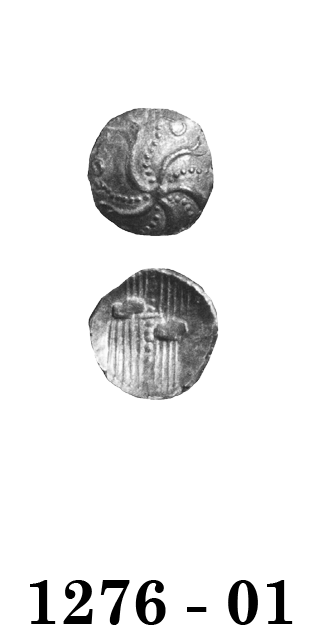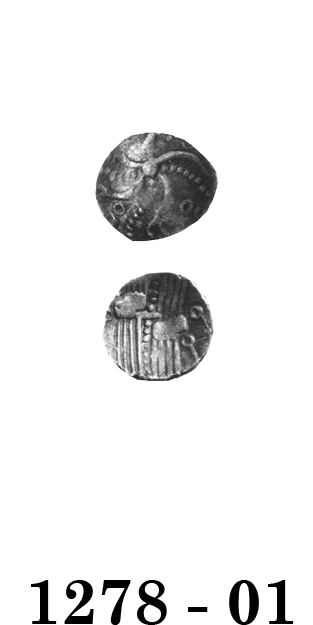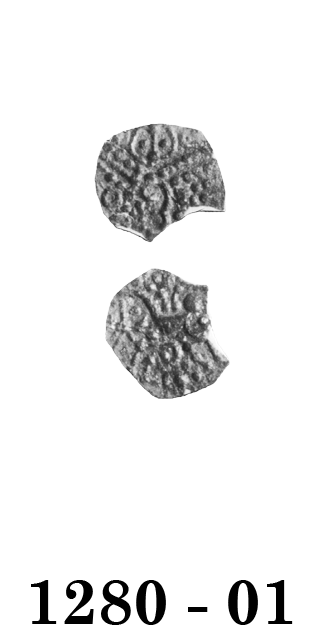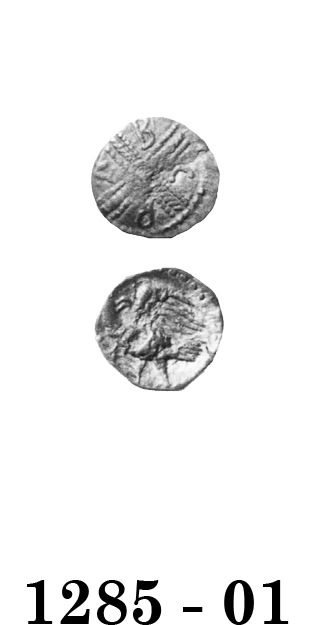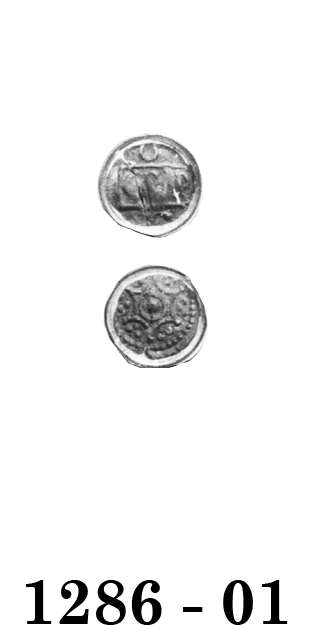
Celtic Coinage of Britain
third edition
Click on coin to see hidden information
Durotrigan Inscribed Silver "Crab" Type
This enigmatic type is arbitrarily assigned to the Durotriges. Too few findspots are known to be certain whether it should be assigned, instead, to the territory of the Atrebates, Regni and Belgae.
No plausible explanation has been offered for the "CRAB" inscription and the proper order of the letters is uncertain. The dating of the issue is problematic.
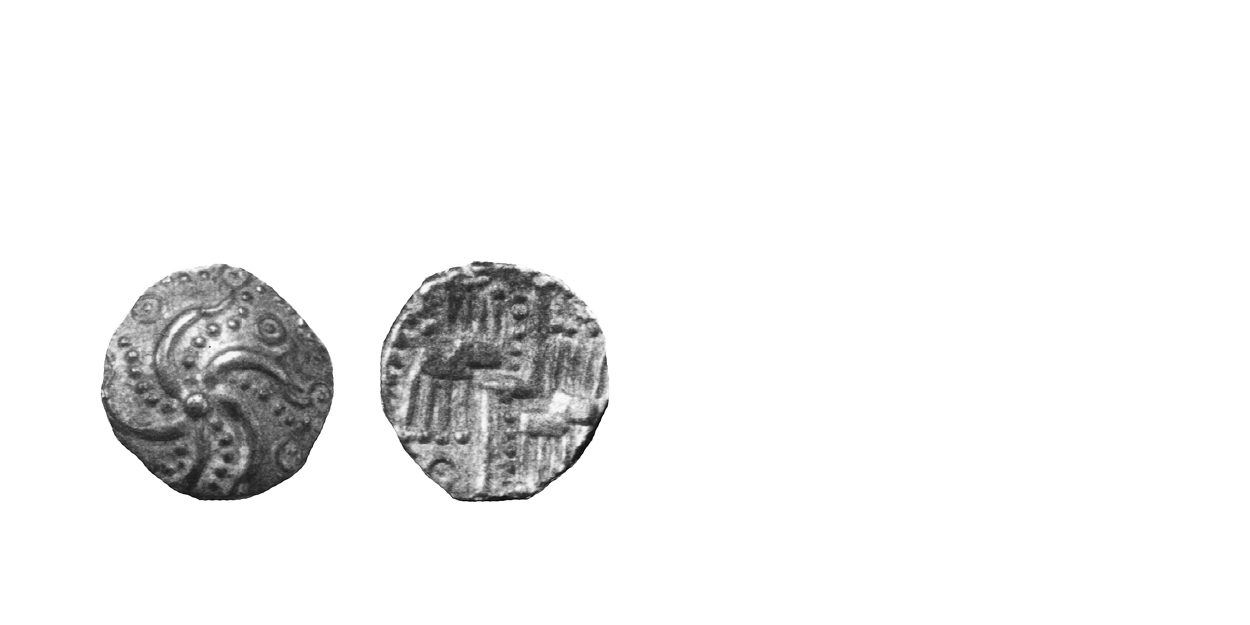
1270 - 01 Starfish Type
35-30 B.C. Scarce
Billon Unit ca. 1.2 gms. 13 mm
Earliest Record: Hill, 1911
OBV: Starfish
Identifying points:
1) five armed starfish with pellet in centre
2) lines of pellets between arms
3) pellet-in-ring motifs in field
REV: zigzag and spider pattern
Identifying points:
1) zigzag with lines of pellets
2) "spider" on either side with eight arms
3) pellet-in-ring motifs in field
CLASSIFICATION: Durotrigan I
NOTES:
- Possibly commoner than indicated, Badbury/Shapwick hoard contents not adequately recorded
- Celtic Coin index records still indicate "scarce"
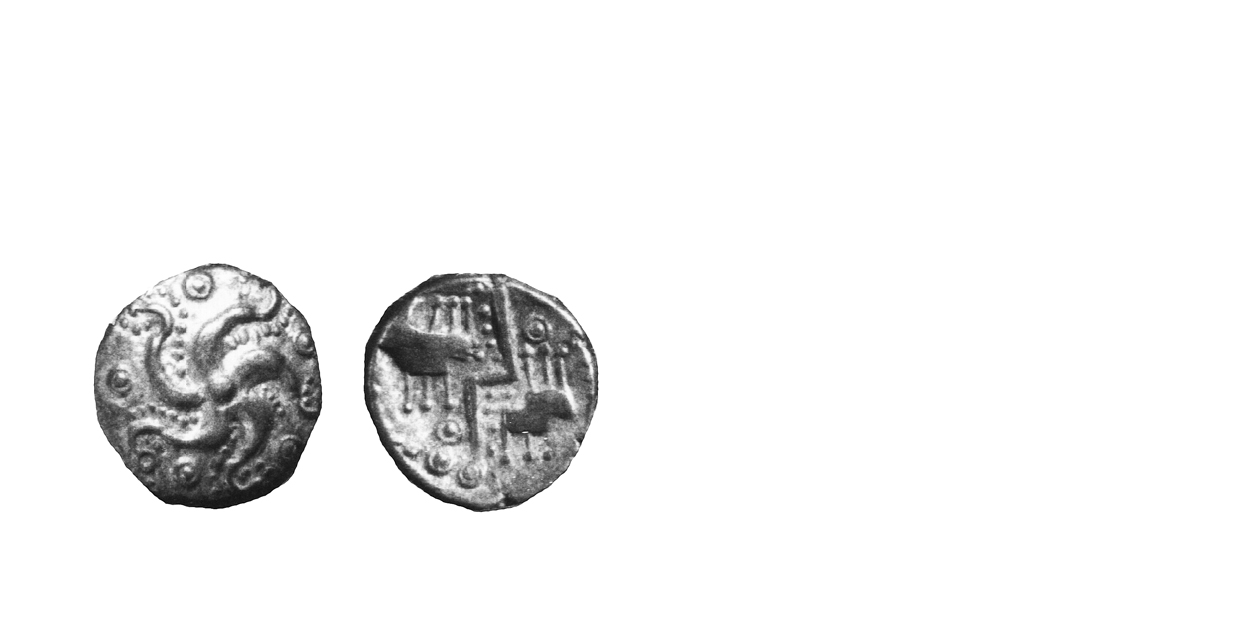
1273 - 01 Thick Starfish Type
35-30 B.C. Rare
Billon Unit ca. 1.1 gms. 12 mm
Earliest Record: Van Arsdell, 1989
OBV: Starfish
Identifying points:
1) similar to 1270 - 01 but starfish has thicker arms
REV: zigzag and spider pattern
Identifying points:
1) similar to 1270 - 01 but spiders have six arms
CLASSIFICATION: Durotrigan I
NOTES:
- This type normally found struck from a damaged reverse die, with a cud forming at one of the spiders
- Rarity estimate of "Scarce", provided via 1980s trade survey, probably overstated tally of known examples
- Celtic Coin Index records suggest type is rarer than previously thought
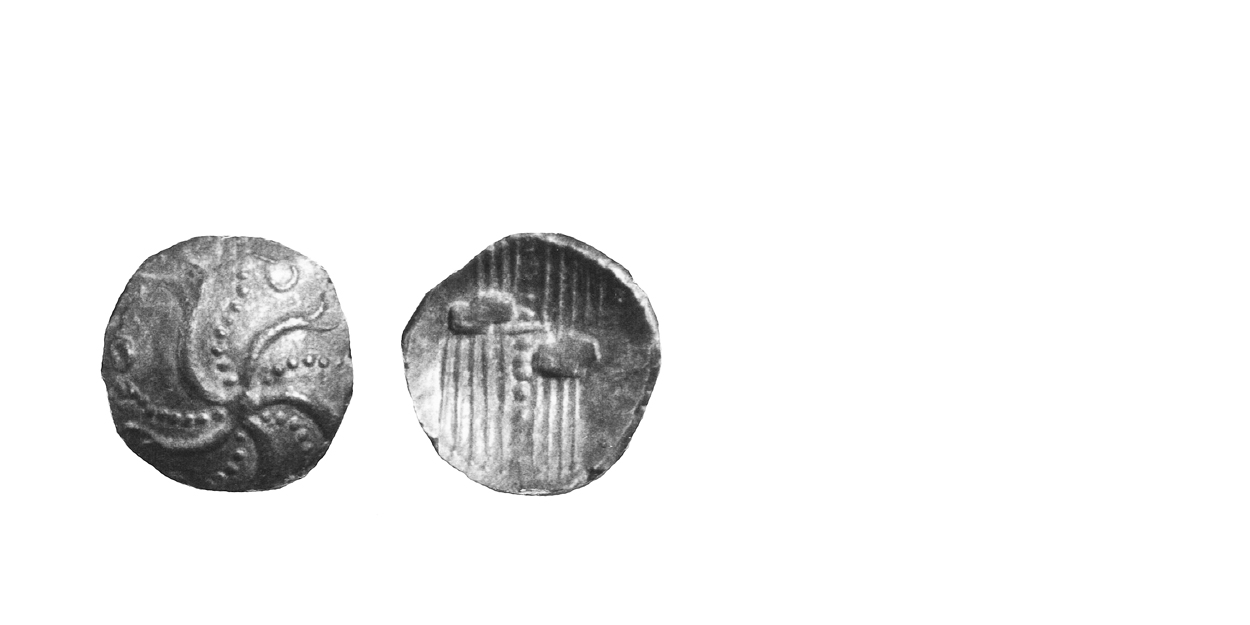
1276 - 01 Elegant Starfish Type
35-30 B.C. Extremely Rare
Billon Unit 0.73 gms. 14 mm
Earliest Record: Van Arsdell,1989
OBV: Starfish
Identifying points:
1) similar to 1270 - 01 but the starfish is thin and elegant
2) the arms of the starfish split into two ends
REV: zigzag and spider pattern
Identifying points:
1) similar to 1270 - 01 but the arms of the spiders are long and thin
2) the field has fewer objects
CLASSIFICATION: Durotrigan I
NOTES:
- Possibly commoner than indicated, Badbury/Shapwick hoard contents not adequately recorded
- Celtic Coin Index records still indicate Extremely Rare
- Weight of extant coin given
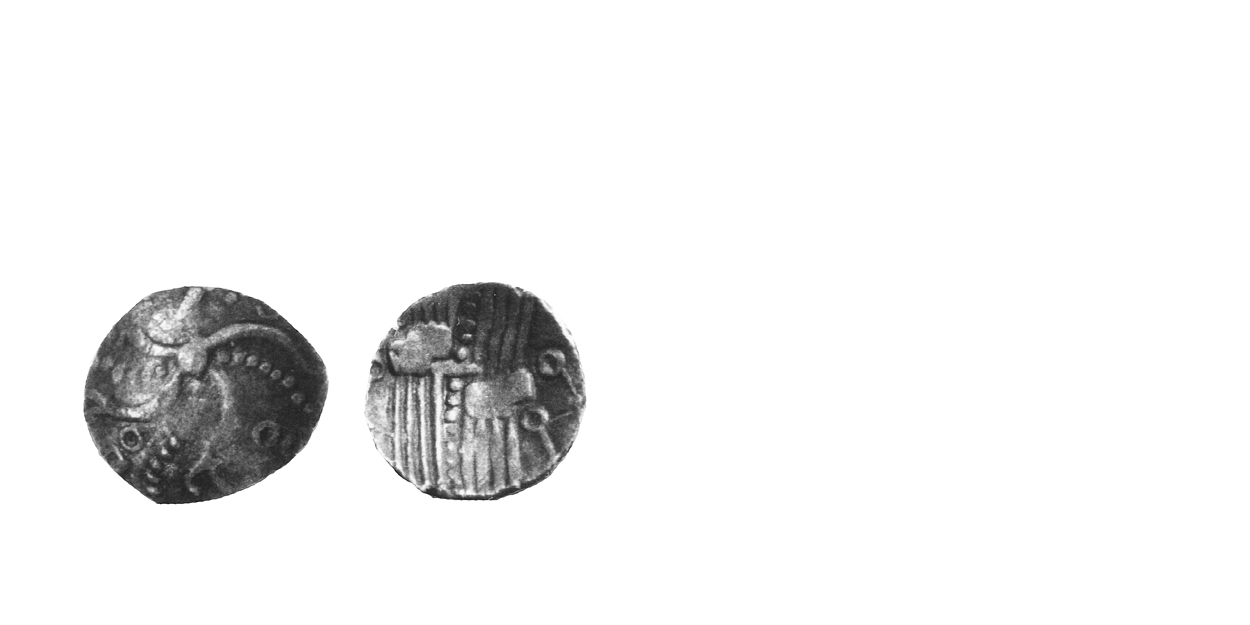
1278 - 01 Elegant Starfish Type
35-30 B.C. Extremely Rare
Billon Fractional Unit 0.55 gms. 12 mm
Earliest Record: Van Arsdell, 1989
OBV: Starfish
Identifying points:
1) similar to 1270 - 01 but the starfish is thin and elegant
2) the arms of the starfish split into two ends
REV: zigzag and spider pattern
Identifying points:
1) as 1276 - 01, but objects added to field
2) ring and "V" objects near spiders
CLASSIFICATION: Durotrigan I
NOTES:
- The relationship of this type to 1276-01 is uncertain, it may represent a lower denomination
- Not enough examples exist to determine the standard weights
- Weight of one of the extant examples given
- The additional objects near the spiders may indicate a change in denomination
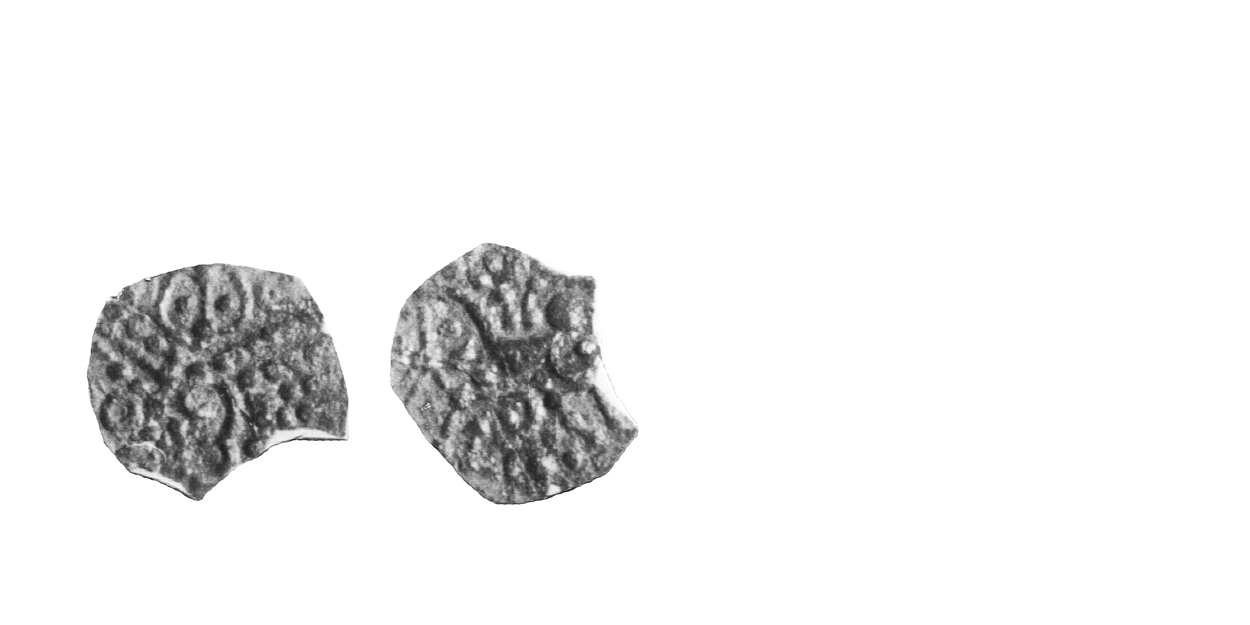
1280 - 01 Thin Silver Type
65-45 B.C. Rare
Silver or Billon Unit 0.8 gms. 15 mm
Earliest Record: Bushe-Fox, 1915
OBV: Pattern of pellets
Identifying points:
1) crude pattern of pellets possibly forming a man
REV: Celticized horse left
Identifying points:
1) crude horse in field of pellets
CLASSIFICATION: None
NOTES:
- Some in museums
- Celtic Coin Index records now indicate commoner than previously thought
- The type is unquestionably genuine, examples were found during excavations at Hengistbury Head in 1911-1912
- Modern forgeries possibly exist, none have been published yet
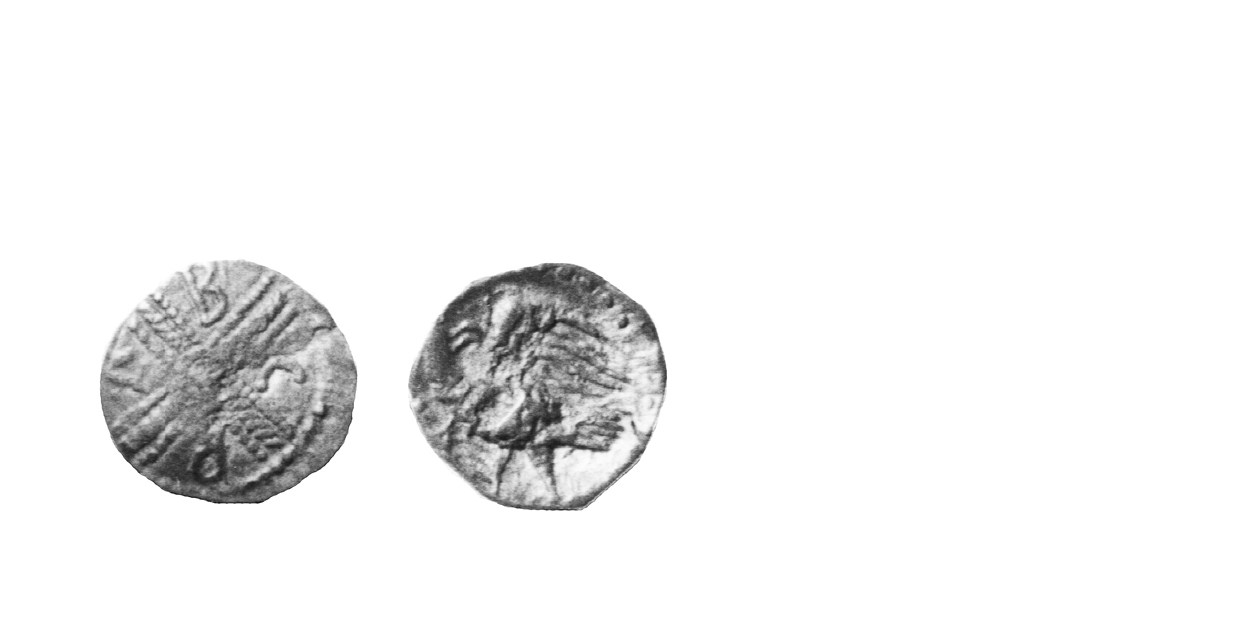
1285 - 01 Crab Type
10-45 A.D. Extremely Rare
Silver Unit 1.1 gms. 13 mm
Earliest Record: Evans, 1890
OBV: Cross with inscription
Identifying points:
1) cross of pellets
2) large pellet and ring in centre
3) CRAB in angles
REV: Eagle
Identifying points:
1) eagle faces left with head turned to face right
CLASSIFICATION: None
NOTES:
- Most in museums
- Possibly Atrebatic/Regnan/Belgic in origin, or influence
- Dating and meaning of the inscription are uncertain
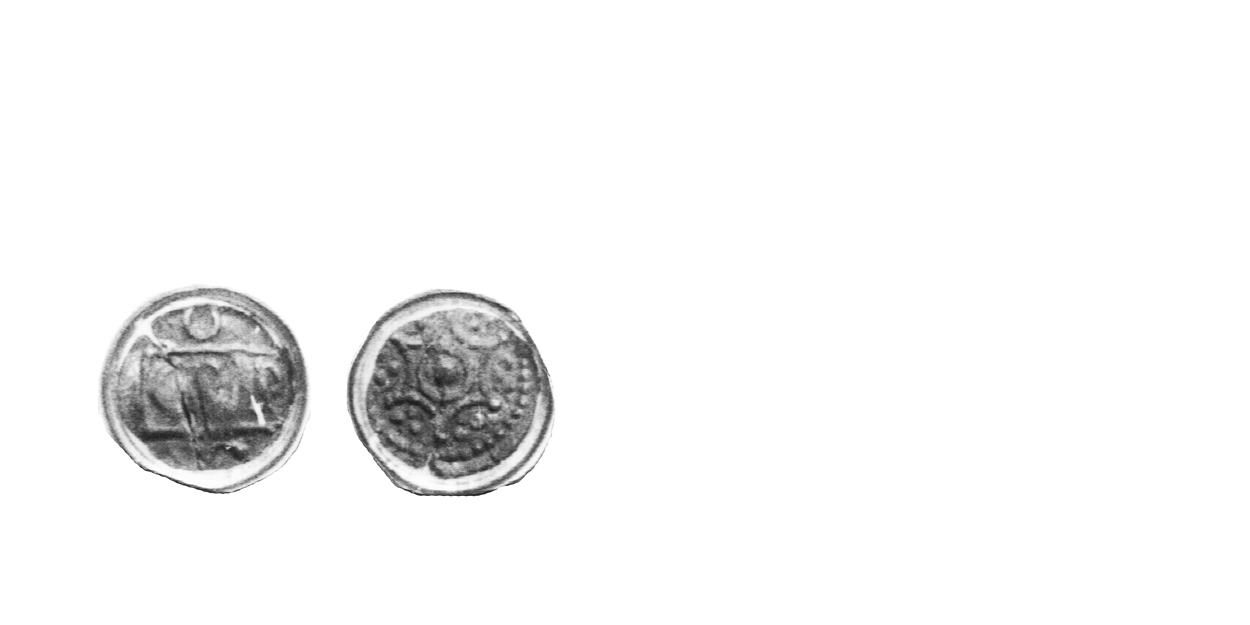
1286 - 01 Crab Type
10-45 A.D. Extremely Rare
Silver Minim 0.3 gms. ca. 0.9 mm
Earliest Record: Evans, 1864
OBV: Tablet with inscription
Identifying points:
1) CRAB in tablet
2) "O" above
3) "S" below
REV: Pattern
Identifying points:
1) pellet-in-ring motif in centre
2) six crescents around central motif to form star pattern
3) triple pellets inside crescents
4) pellet border
CLASSIFICATION: None
NOTES:
- Most in museums
- The type was recorded by Evans, see Evans, 1864, p. 214
- Possibly Atrebatic/Regnan/Belgic in origin, or influence.
- Dating Uncertain
Durotrigan Uninscribed Silver Starfish Type
The starfish type appears to follow the geometric types, because it continues the zigzag pattern decorated with lines of pellets.
The Coinage of the Durotriges
The Durotriges occupied all of Dorset, parts of Somerset, Wiltshire and Hampshire. They had extensive trading contacts with the Armorican peninsula and consequently their coinage was unlike that of the other British tribes. Armorican coins were primarily silver and billon, and the bulk of the Durotrigan coinage was made of these metals instead of gold.
After their first issues, the Durotriges ignored the mainstream of British coinage, suggesting they were economically isolated. Moreover, their coins circulated less and less beyond the tribal boundaries as time went on, and as the tribe's isolation increased.
Initially however, the Durotrigan coinage was an integral part of the economy of southern Britain. Their first coins were inspired by those of the Atrebates/Regni and these did circulate beyond the tribal borders. The CHUTE TYPE, a gold stater first struck about 65 B.C., was adapted from the Southern Westerham Type of the Atrebates/Regni/Belgae. The Durotrigan moneyers evidently struck the staters using the correct alloy and standard weight at the outset. The Atrebatic/Regnan/Belgic influence was short lived, however, for the tribe had converted to an Armorican-style silver coinage by the middle of the Gallic War.
At the beginning of the Gallic War, the Durotriges did two divergent things to their gold coinage. First, they struck a series of gold staters of increasingly lighter weight and lower gold content. The Chute Type was replaced by the CHUTE-CHERITON TRANSITIONAL TYPE and finally the CHERITON TYPE.
One Cheriton Type Stater has been analyzed metallurgically, and has been found to have a high tin content. This suggests the Durotriges were debasing their gold staters with addition of bronze to the alloy. The Cheriton staters perhaps represented an emergency attempt to maintain a gold coinage for trade with the other British tribes. If this was the case, the attempt failed because production soon stopped.
The second change to the coinage was the introduction of a Southern Westerham Type copy in white gold, which rapidly became debased to silver, billon and ultimately bronze. These coins, although occasionally found outside the tribe's territory, were primarily used in the Durotrigan economy since no other tribe used such coins. The series was long-lived, with many types issued in succession. The silver stater and its billon descendants are accompanied by fractional denominations.
Whether the Durotriges went to a silver standard because of the preferences of their Armorican partners, or because they simply ran out of gold bullion, is uncertain. Their trading contacts used mostly silver coins, and by the time of the Gallic War were using them exclusively. After the defeat of the Venetic Fleet and conquest of Armorica by the Romans, the Durotriges ran out of bullion of all types, because their trade with the continent was cut off. They had already been excluded from the British trading networks by strong competition from the Atrebates/Regni/Belgae and Trinovantes/Catuvellauni. Durotrigan silver coins ceased about 30 B.C., and were replaced by struck bronze staters of increasingly crude style. The silver fractional denominations disappeared entirely.
A series of cast bronzes follows, starting probably in the first century A.D., and known mostly from two large hoards. A small number of extremely rare silver coins carrying the inscription CRAB are found in Durotrigan territory. Although these pieces appear Atrebatic/Regnan/Belgic in style, they have been attributed traditionally to the Durotriges because of the findspots.
The Durotrigan coinage would have come to an end in the mid-forties A.D. as Vespasian's legions overran the tribal territory. The tribe offered difficult resistance to the Roman invasion and their coinage would have been ruthlessly suppressed. Durotrigan coins are sometimes found in surprisingly late hoards of Roman pieces, but probably these represented curiosities at the time of deposit.
The site of the Durotrigan mint has never been located with certainty, and several mints may have been in operation. One likely place was the trading port at Hengistbury. Some of the rare varieties of billon staters may have been irregular issues, struck by local authorities.
The moneyers produced flans by the 'Flat Rock' method, pouring molten metal directly on a smooth surface. Some of the coins display splash appendages produced during the flan pouring operation. The Durotriges learned the technique from Armorican moneyers, whose coins also show the appendages. The early gold and silver coins were well-struck, but the later billon ones were hastily produced in enormous numbers and were consequently less well made. The manufacturing methods for the cast coins have never been studied, and represent an opportunity for original research.
A number of plated forgeries of silver staters are known and sometimes it is difficult to distinguish between plated cores and struck bronzes. Conceivably, all struck bronzes may originally have been silver coated.
